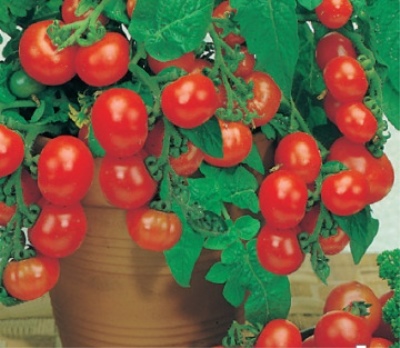
- Authors: Lukyanenko A.N., Dubinin S.V., Dubinina I.N.
- Year of approval: 2010
- Category: grade
- Growth type: determinant
- Appointment: fresh consumption, for whole fruit preservation
- Ripening period: ultra early
- Ripening time, days: 85-90
- Growing conditions: for open ground, for film greenhouses, pot culture
- Bush size: undersized
- Bush height, cm: 20-30
Such a chic name for the pearl red tomato does not mean that gardeners should immediately rush to plant this crop in any chosen place. On the contrary, you should get to know it thoroughly, and only then get down to business. Noteworthy is both the level of fertility and the basic scheme of garden work.
Breeding history
The Red Pearl variety was created in the 2000s. This crop was officially approved for cultivation in private gardens in 2010. The work on the project was carried out by a group of breeders consisting of:
A. N. Lukyanenko;
I. N. Dubinina;
S. V. Dubinina.
Description of the variety
Pearl red is a common determinant tomato. The height of its bushes does not exceed 20-30 cm, which greatly facilitates growing in a greenhouse. However, the same property imposes objective restrictions on the amount of harvested fruits. The small leaves of such a plant are dark green in color. Another characteristic feature is the formation of a trunk.
The main qualities of the fruit
The earliest berries to form will be green. Another feature that makes the Red Pearl akin to a number of other varieties of tomatoes is a rich green spot in the region of the stalk. The berries themselves belong to the category of cherry, can weigh from 20-30 g. They have a rounded shape and a simple smooth surface, without any spouts and other complications of geometry. Tomatoes develop from a simple inflorescence on articulated stalks.
Taste characteristics
The share of dry matter in fruits reaches 6%. The flesh inside them is of medium density.
Ripening and fruiting
Its ultra-early character is rightly considered an important advantage of this variety. This allows you to confidently grow tomatoes even in risky farming areas. You can wait for the readiness of the crop 85-90 days after pecking the seedlings.
Yield
The number of fruits reaches 5 kg per 1 sq. m. This only seems like a small figure. In reality, if we take into account the parameters of the plant, the result will be perceived completely differently.
The timing of planting seedlings and planting in the ground
In the middle lane, the red pearl can be cultivated exclusively by the seedling method. It is necessary to sow seeds in containers no earlier than mid-March. But postponing such work until April, even in its first decade, is not good. Somewhere in between these moments, gardeners can do all the necessary manipulations calmly. Landing in greenhouses is usually carried out from May 1 to May 15, and in open land - usually in the second half of May; the main thing here is not the calendar period, but the absence of the risk of frost return.

Growing tomato seedlings is an extremely important process, because it largely depends on whether the gardener will be able to harvest at all. All aspects must be taken into account, from seedbed preparation to planting in the ground.
Landing scheme
Traditionally, for many tomato varieties, the rule of 4 bushes per 1 square meter is chosen here. m. But this is only their largest concentration.If possible, you should reduce it to make it easier for yourself to worry about planting.

Growing and care
Due to the low height of such tomatoes, it is not required to pinch and shape them. And it's hard to imagine how it might look in practice. Suppliers of planting material insist on the resistance of this plant to verticillosis. However, preventive treatments will definitely not hurt. Watering tomatoes under normal conditions should be weekly.
This is done diligently, using 1 liter of water per plant. If it is arid, especially hot, weather, the intensity of irrigation can be increased. Systematic work on weeding and loosening the earth is very important. Top dressing is applied a maximum of 3 times during the growing season - in addition to this schedule, fertilizers are used only when urgently needed. Prevention of most diseases is achieved by spraying with "Fitosporin" or Bordeaux liquid.




A plant needs different micronutrients at each stage of growth. All fertilizers can be divided into two groups: mineral and organic. Folk remedies are often used: iodine, yeast, bird droppings, eggshells.
It is important to observe the rate and period of feeding. This also applies to folk remedies and organic fertilizers.


Growing regions
The red pearl will equally delight the farmers of the Moscow region and the Volga basin. Ural and Siberian gardeners will also be satisfied with a similar plant. In addition to these areas, it can be grown:
in the Far East;
in the North Caucasus;
in the Black Earth Region;
throughout the European part of Russia, not excluding its north, northwest.

























































































